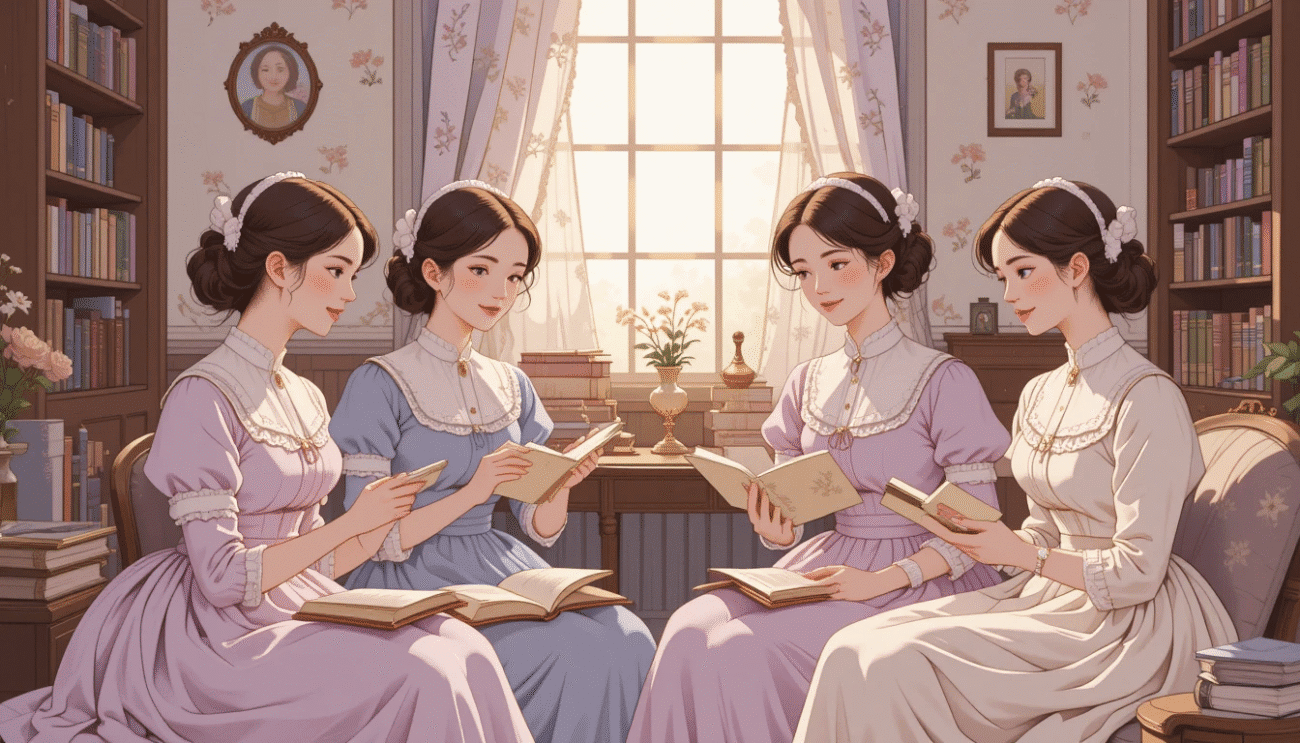Have you ever wondered what makes Little Women by Louisa May Alcott a beloved classic that resonates across generations? This heartwarming novel, set during the Civil War, follows the lives of the four March sisters—Meg, Jo, Beth, and Amy—as they navigate love, loss, and personal growth. For readers, students, or book club enthusiasts, understanding its rich themes and characters can deepen your appreciation. In this article, you’ll discover a detailed book summary of Little Women, key insights, and why it remains a literary treasure.
Table of Contents
Overview of Little Women
Little Women, published in 1868–1869, is a semi-autobiographical novel by Louisa May Alcott. Set in Concord, Massachusetts, it follows the March sisters—Meg, Jo, Beth, and Amy—as they transition from adolescence to adulthood. Facing poverty, societal expectations, and personal dreams, the sisters rely on their bond and moral compass, guided by their mother, Marmee.
The novel is divided into two parts. Part one focuses on their childhood, filled with small joys and struggles, while part two explores their adult lives, including love and career aspirations. Alcott’s vivid storytelling captures the essence of family and resilience.
A Snapshot of the Plot
The story begins at Christmas, with the sisters lamenting their lack of wealth. Through trials like Meg’s longing for luxury, Jo’s literary ambitions, Beth’s health struggles, and Amy’s artistic pursuits, they learn valuable lessons. Their relationships with Laurie, their neighbor, and others shape their journeys.
Highlight: “I am not afraid of storms, for I am learning how to sail my ship,” Jo says, embodying the novel’s spirit of courage. Louisa May Alcott Society
Main Characters and Their Arcs
Each March sister represents a unique personality, making Little Women relatable to diverse readers. Their growth is central to the book summary of Little Women.
Meg March
The eldest, Meg, dreams of a comfortable life but learns contentment in simplicity. Her journey from vanity to embracing family life is inspiring.
Jo March
Jo, the tomboyish writer, defies gender norms. Her ambition and independence resonate with modern readers, making her a feminist icon.
Beth March
Shy and musically gifted, Beth’s gentle nature touches everyone. Her health challenges highlight themes of sacrifice and love.
Amy March
The youngest, Amy, evolves from a vain artist to a refined woman. Her pursuit of beauty and grace adds depth to the story.
Table: March Sisters’ Key Traits
| Sister | Key Trait | Core Struggle |
|---|---|---|
| Meg | Romantic | Desire for luxury |
| Jo | Independent | Societal expectations |
| Beth | Gentle | Health issues |
| Amy | Artistic | Vanity |
Key Themes in Little Women
The book summary of Little Women is incomplete without exploring its universal themes. These resonate with readers seeking meaning in life’s challenges.
Family and Sisterhood
The March sisters’ bond is the heart of the novel. Their love and conflicts reflect real family dynamics, offering comfort to readers.
Personal Growth
Each sister overcomes flaws, teaching readers about resilience. Alcott shows that growth is a lifelong journey, not a destination.
Gender Roles
Jo’s defiance of traditional roles challenges 19th-century norms. This theme remains relevant, inspiring discussions on equality.
Tip: Reflect on how the sisters’ struggles mirror your own. Journaling about their lessons can deepen your connection to the story.
Quote: “Women, they have minds, and they have souls, as well as just hearts,” Marmee says, emphasizing empowerment. Project Gutenberg
Historical Context and Impact
Understanding the historical backdrop enriches the book summary of Little Women. Written during the Civil War, it reflects the era’s social and economic challenges. Women faced limited opportunities, yet Alcott’s progressive views shine through.
Civil War Setting
The war shapes the March family’s struggles, with their father absent and poverty looming. This context grounds the story in resilience.
Alcott’s Legacy
Alcott drew from her own life, making the novel authentic. Its success influenced women’s literature, inspiring authors like J.K. Rowling.
Statistic: Over 10 million copies of Little Women have been sold worldwide, per Penguin Classics, proving its enduring appeal.
Why Read Little Women Today?
Why does Little Women remain relevant? Its timeless lessons appeal to modern readers. The novel’s focus on individuality and resilience inspires.
Relatability
Readers see themselves in the sisters’ diverse personalities. Whether you’re a dreamer like Jo or nurturing like Beth, there’s a connection.
Life Lessons
The novel teaches balance between ambition and contentment. It encourages readers to embrace their unique paths.
Tip: Join a book club to discuss Little Women. Sharing insights can enhance your reading experience!
Frequently Asked Questions
What is the main theme of Little Women?
The main themes of Little Women include family, personal growth, and gender roles. The March sisters’ journeys highlight resilience and sisterhood, offering timeless lessons for readers seeking inspiration.
Who is the protagonist in Little Women?
Jo March is often considered the protagonist, though all four sisters—Meg, Jo, Beth, and Amy—are central. Jo’s bold personality and ambitions drive much of the narrative.
Why is Little Women a classic?
Little Women is a classic due to its relatable characters, universal themes, and historical significance. Its exploration of family and individuality resonates across generations.
How does Little Women reflect the Civil War?
The Civil War shapes the March family’s struggles, with their father serving as a chaplain and poverty affecting their lives. It grounds the story in resilience.
Is Little Women autobiographical?
Yes, Little Women is semi-autobiographical. Louisa May Alcott drew from her own life, with Jo reflecting her personality and the March family mirroring her own.
Conclusion
This book summary of Little Women highlights why Alcott’s novel endures. The March sisters’ journeys through love, loss, and growth offer timeless lessons. From Jo’s defiance to Beth’s kindness, their stories inspire readers to embrace individuality. Whether you’re revisiting the classic or discovering it anew, Little Women invites reflection. Dive into the novel or share your thoughts in a book club. What lessons will you take from the March sisters? Get your copy today!
